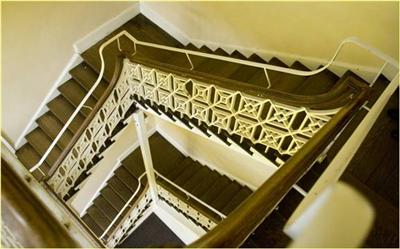In nearby Charlton Park, visualizing the house's interior a century later, requires a little imagination, assisted by the 'Cheltenham Looker-On' (24 May 1884) and a letting advertisement:
"TO BE LET (Unfurnished), with immediate possession upon a Yearly Tenancy, or for a Term, the MANSION and Grounds, known as "CHARLTON PARK," containing Entrance Hall opening into Central Saloon (suitable for a Billiard Room), Morning Room, Dining and Drawing Rooms, Library, Servants' Hall, Pantry, Large Kitchen, and convenient Offices, nine good Bed Rooms on First Floor, Twelve Bed Rooms and Attics on Second Floor, Stabling for Twelve Horses, with Two Coach Houses, Saddle Room and Cottage, large Tennis Lawn, with extensive Shrubberies and Grounds and Ornamental Water of Two Acres. The Front Rooms overlook the magnificently Timbered Park, in which is the Cricket Ground of the East Gloucestershire Club, to which the Resident at the Mansion has a Private Entrance. Four Packs of Foxhounds are within easy reach. Rent, £250 per Annum. Pasture Land in the Park can be rented if desired".
Furnished with such oil-on-canvas, print-on-paper imagery almost allows us to be transported into the old mansion house, where a very keen ear can 'virtually' hear the busy servants exchanging the latest gossip, or to the estate office where Mr. Prinn and his bailiff are discussing the day's tasks on Home Farm, or to the stable yard where the clatter of hooves on cobbles mixes with chatter of lads helping a driver prepare the carriage to take the 'master' to the Plough Hotel, as doves beat the air near the dovecote and a rutting stag slips unnoticed through the iron gate carelessly left open by a local lad who hastily departed after 'scrumping' more apples from Mr Prinn's orchard. And thus it ever was on such busy Cotswold estates, a mixture of bucolic rustics at one end of the scale and landed gentry at the other, each mutually reliant on the skills and entrepreneurialism of the other to get on in life, or just to get through it. Today the sounds are of course quite different. No longer is there a cacophony of poultry, livestock, horses and estate staff. Excluding pack-hounds, today's sounds include plenty of people with dogs and the nearby bells of St Mary's continue to ring out across the park. Probably the only other long-term sound that man had a hand in creating is the roar of the central waterfall, especially after a storm, and this particular audible continuity might one day prove the most enduring of them all - as well as continuing to create more headaches and challenges a little further downstream, after joining forces with the Chelt.
Robins' painting certainly allows us to appreciate something of the splendour various owners of the estate created here. To this we may add a few internal treasures, such as the oval drawing room with its Adam-type plasterwork, wainscoted and panelled rooms, fine paintings, drapes, furniture and fittings, Doddington Hunt's magnificent Chinese Chippendale staircase and a whole lot more, after which, even if others have since decided otherwise, it surely begins to rival some of Gloucestershire's finest country houses. Although Robins' painting permits only an external view, the interior can be envisioned as befittingly magnificent and the main supporting clue to this magnificence is the irrefutable fact that Doddington Hunt (son-in-law of William Prinn, whose son took the name William Hunt Prinn) successfully invited and hosted the King of England here in 1788, where they would have ascended Chippendale's fine piece of craftsmanship to the first floor drawing room together, where such an honoured guest would undoubtedly have been lavishly entertained.
 © Cotswold ImagesThe beautiful Chinese Chippendale staircase in 2008, with additional embellishments
© Cotswold ImagesThe beautiful Chinese Chippendale staircase in 2008, with additional embellishments
to meet the modern safety standards of a school
John Prinn was also a distinguished antiquary and archaeologist so if anyone ever found traces of Charlton Park's historic past it was probably he, but we have no knowledge of such discoveries. The Prinns remained at Charlton Park during the eighteenth century, until the estate passed to their collateral descendants, the Russells, and in 1873 the estate is said to have comprised some 1446 acres, incorporating many local farms, but property fortunes were subject to much the same turmoil as today as such fortunes frequently came and went.
